heating Alfa Romeo 166 2006 Owner handbook (in English)
[x] Cancel search | Manufacturer: ALFA ROMEO, Model Year: 2006, Model line: 166, Model: Alfa Romeo 166 2006Pages: 272, PDF Size: 4.17 MB
Page 14 of 272
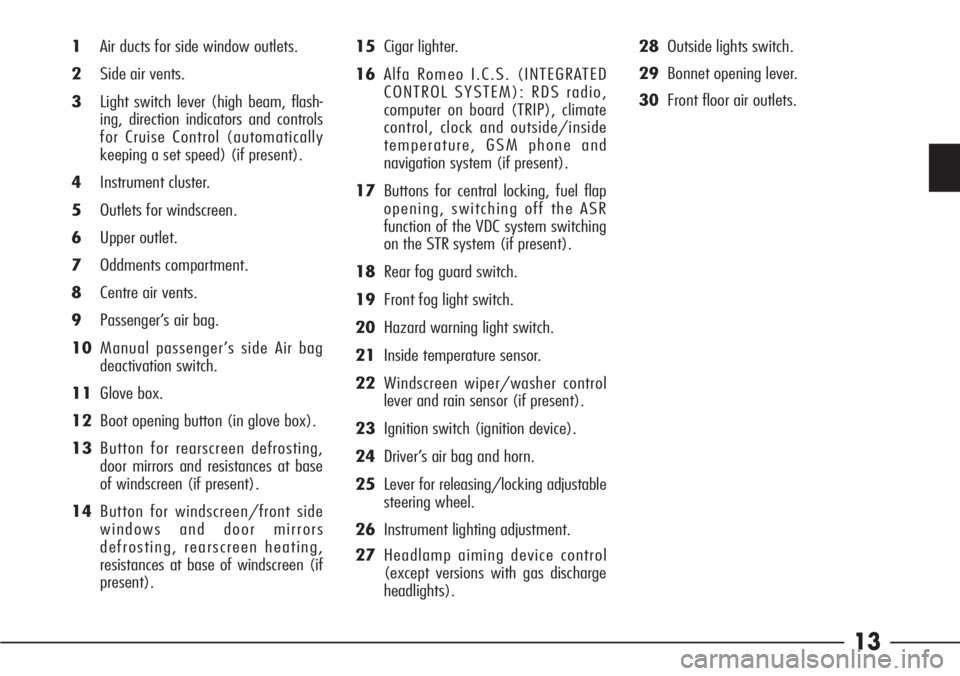
13
1Air ducts for side window outlets.
2Side air vents.
3Light switch lever (high beam, flash-
ing, direction indicators and controls
for Cruise Control (automatically
keeping a set speed) (if present).
4Instrument cluster.
5Outlets for windscreen.
6Upper outlet.
7Oddments compartment.
8Centre air vents.
9Passenger’s air bag.
10Manual passenger’s side Air bag
deactivation switch.
11Glove box.
12Boot opening button (in glove box).
13Button for rearscreen defrosting,
door mirrors and resistances at base
of windscreen (if present).
14Button for windscreen/front side
windows and door mirrors
defrosting, rearscreen heating,
resistances at base of windscreen (if
present).15Cigar lighter.
16Alfa Romeo I.C.S. (INTEGRATED
CONTROL SYSTEM): RDS radio,
computer on board (TRIP), climate
control, clock and outside/inside
temperature, GSM phone and
navigation system (if present).
17Buttons for central locking, fuel flap
opening, switching off the ASR
function of the VDC system switching
on the STR system (if present).
18Rear fog guard switch.
19Front fog light switch.
20Hazard warning light switch.
21Inside temperature sensor.
22Windscreen wiper/washer control
lever and rain sensor (if present).
23Ignition switch (ignition device).
24Driver’s air bag and horn.
25Lever for releasing/locking adjustable
steering wheel.
26Instrument lighting adjustment.
27Headlamp aiming device control
(except versions with gas discharge
headlights).28Outside lights switch.
29Bonnet opening lever.
30Front floor air outlets.
Page 33 of 272
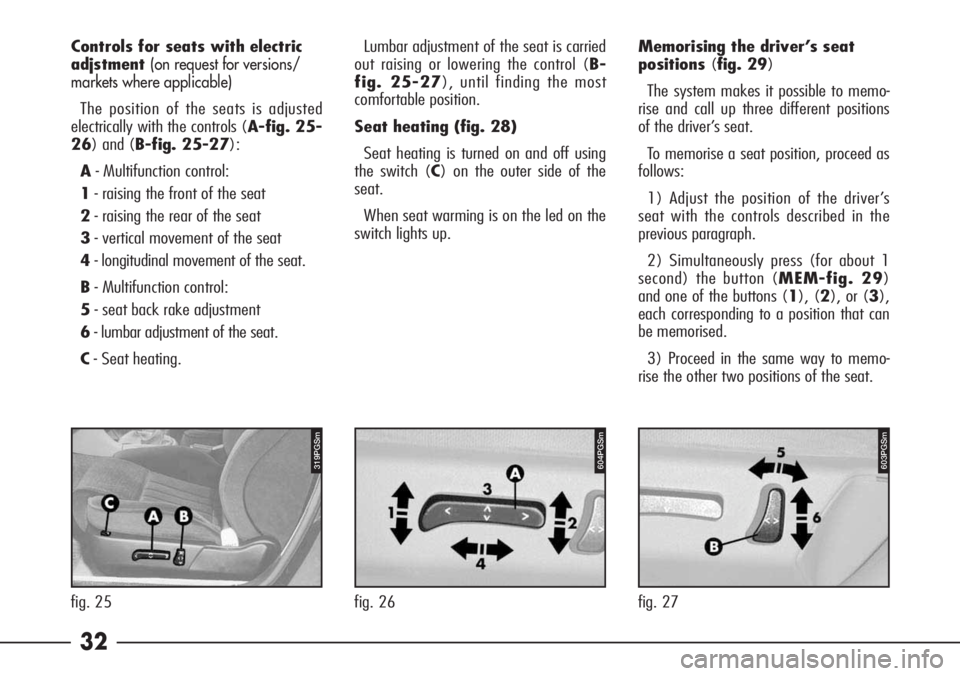
32
Controls for seats with electric
adjstment
(on request for versions/
markets where applicable)
The position of the seats is adjusted
electrically with the controls (A-fig. 25-
26) and (B-fig. 25-27):
A- Multifunction control:
1- raising the front of the seat
2- raising the rear of the seat
3- vertical movement of the seat
4- longitudinal movement of the seat.
B- Multifunction control:
5- seat back rake adjustment
6- lumbar adjustment of the seat.
C- Seat heating.Lumbar adjustment of the seat is carried
out raising or lowering the control (B-
fig. 25-27), until finding the most
comfortable position.
Seat heating (fig. 28)
Seat heating is turned on and off using
the switch (C) on the outer side of the
seat.
When seat warming is on the led on the
switch lights up.Memorising the driver’s seat
positions(fig. 29)
The system makes it possible to memo-
rise and call up three different positions
of the driver’s seat.
To memorise a seat position, proceed as
follows:
1) Adjust the position of the driver’s
seat with the controls described in the
previous paragraph.
2) Simultaneously press (for about 1
second) the button (MEM-fig. 29)
and one of the buttons (1), (2), or (3),
each corresponding to a position that can
be memorised.
3) Proceed in the same way to memo-
rise the other two positions of the seat.
fig. 26 fig. 25
319PGSm604PGSm
fig. 27
603PGSm
Page 34 of 272
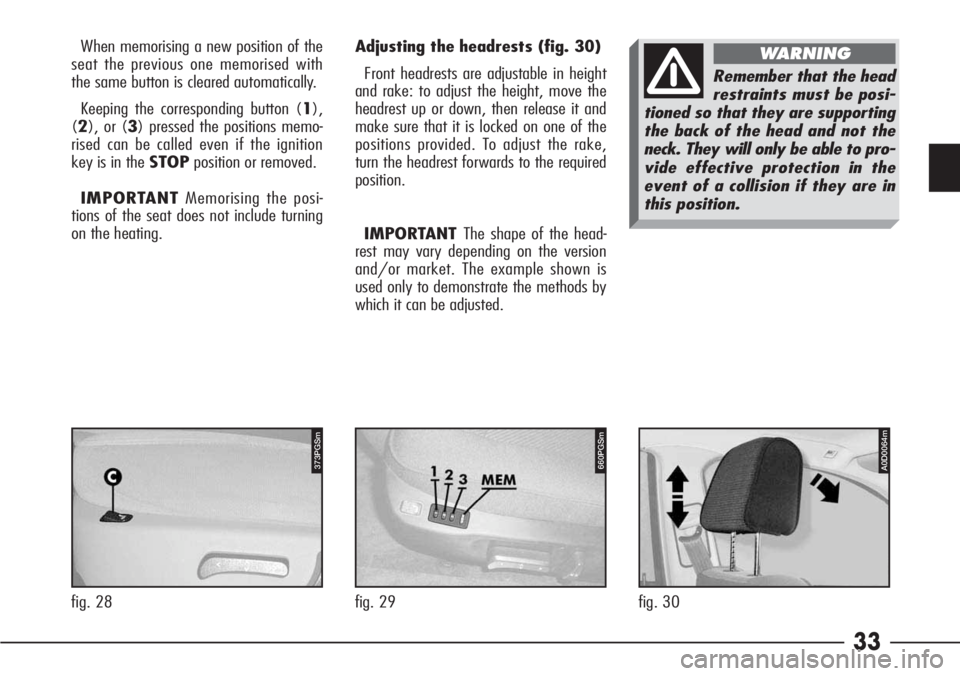
33
Adjusting the headrests (fig. 30)
Front headrests are adjustable in height
and rake: to adjust the height, move the
headrest up or down, then release it and
make sure that it is locked on one of the
positions provided. To adjust the rake,
turn the headrest forwards to the required
position.
IMPORTANT The shape of the head-
rest may vary depending on the version
and/or market. The example shown is
used only to demonstrate the methods by
which it can be adjusted. When memorising a new position of the
seat the previous one memorised with
the same button is cleared automatically.
Keeping the corresponding button (1),
(2), or (3) pressed the positions memo-
rised can be called even if the ignition
key is in the STOPposition or removed.
IMPORTANTMemorising the posi-
tions of the seat does not include turning
on the heating.
Remember that the head
restraints must be posi-
tioned so that they are supporting
the back of the head and not the
neck. They will only be able to pro-
vide effective protection in the
event of a collision if they are in
this position.
WARNING
fig. 28
373PGSm
fig. 30
A0D0064m
fig. 29
660PGSm
Page 38 of 272
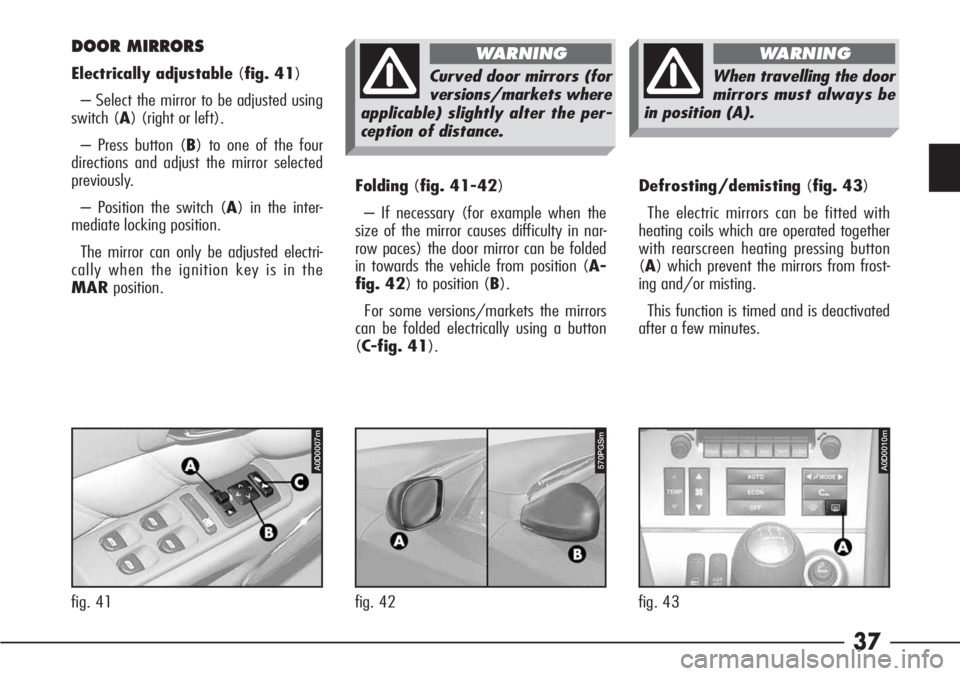
37
Folding(fig. 41-42)
– If necessary (for example when the
size of the mirror causes difficulty in nar-
row paces) the door mirror can be folded
in towards the vehicle from position (A-
fig. 42) to position (B).
For some versions/markets the mirrors
can be folded electrically using a button
(C-fig. 41).Defrosting/demisting(fig. 43)
The electric mirrors can be fitted with
heating coils which are operated together
with rearscreen heating pressing button
(A) which prevent the mirrors from frost-
ing and/or misting.
This function is timed and is deactivated
after a few minutes.
DOOR MIRRORS
Electrically adjustable (fig. 41)
– Select the mirror to be adjusted using
switch (A) (right or left).
– Press button (B) to one of the four
directions and adjust the mirror selected
previously.
– Position the switch (A) in the inter-
mediate locking position.
The mirror can only be adjusted electri-
cally when the ignition key is in the
MARposition.Curved door mirrors (for
versions/markets where
applicable) slightly alter the per-
ception of distance.
WARNING
When travelling the door
mirrors must always be
in position (A).
WARNING
fig. 41
570PGSm
fig. 42fig. 43
P4C00057A0D0007mA0D0010m
Page 44 of 272
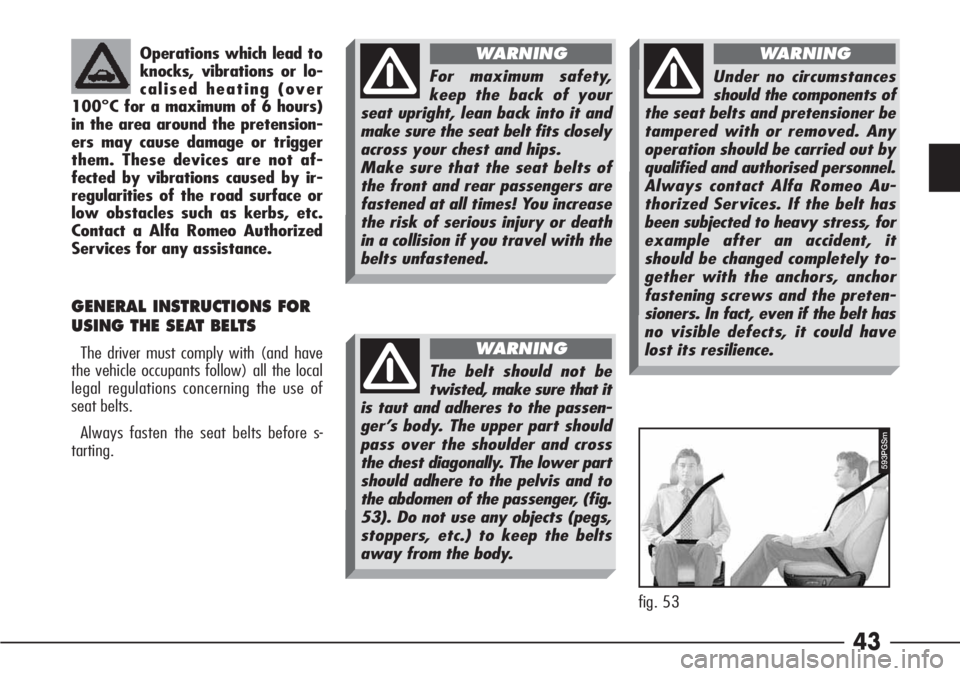
43
Operations which lead to
knocks, vibrations or lo-
calised heating (over
100°C for a maximum of 6 hours)
in the area around the pretension-
ers may cause damage or trigger
them. These devices are not af-
fected by vibrations caused by ir-
regularities of the road surface or
low obstacles such as kerbs, etc.
Contact a Alfa Romeo Authorized
Services for any assistance.
GENERAL INSTRUCTIONS FOR
USING THE SEAT BELTS
The driver must comply with (and have
the vehicle occupants follow) all the local
legal regulations concerning the use of
seat belts.
Always fasten the seat belts before s-
tarting.
For maximum safety,
keep the back of your
seat upright, lean back into it and
make sure the seat belt fits closely
across your chest and hips.
Make sure that the seat belts of
the front and rear passengers are
fastened at all times! You increase
the risk of serious injury or death
in a collision if you travel with the
belts unfastened.
WARNING
The belt should not be
twisted, make sure that it
is taut and adheres to the passen-
ger’s body. The upper part should
pass over the shoulder and cross
the chest diagonally. The lower part
should adhere to the pelvis and to
the abdomen of the passenger, (fig.
53). Do not use any objects (pegs,
stoppers, etc.) to keep the belts
away from the body.
WARNING
Under no circumstances
should the components of
the seat belts and pretensioner be
tampered with or removed. Any
operation should be carried out by
qualified and authorised personnel.
Always contact Alfa Romeo Au-
thorized Services. If the belt has
been subjected to heavy stress, for
example after an accident, it
should be changed completely to-
gether with the anchors, anchor
fastening screws and the preten-
sioners. In fact, even if the belt has
no visible defects, it could have
lost its resilience.
WARNING
593PGSm
fig. 53
Page 82 of 272

81
The passenger compartment climate
control (heating, cooling and ventilation)
can be used in the following ways:
– manual climate control, by selecting
the functions using the control panel but-
tons;
– automatic climate control, managed
by the system electronic control unit.ADJUSTING THE CENTRE
UPPER VENT
(fig. 89)
The upper vent is fitted with an open-
ing/closing control (A)
O= Completely open
●= completely closed.
368PGSm
fig. 89 The air is admitted to the passenger
compartment through a series of out-
lets/vents located on the dashboard, on
the front door panels, centre console and
floor as illustrated (fig. 88):
1Centre vents for demisting/defrosting
the windscreen
2Upper adjustable centre vent
3Central movable and adjustable out-
lets
4Movable and adjustable side outlets
5Vents for demisting/defrosting the
side windows
6Front seat floor vents
7Rear seat floor vents
8Rear seat adjustable and movable
outlets.
Page 85 of 272
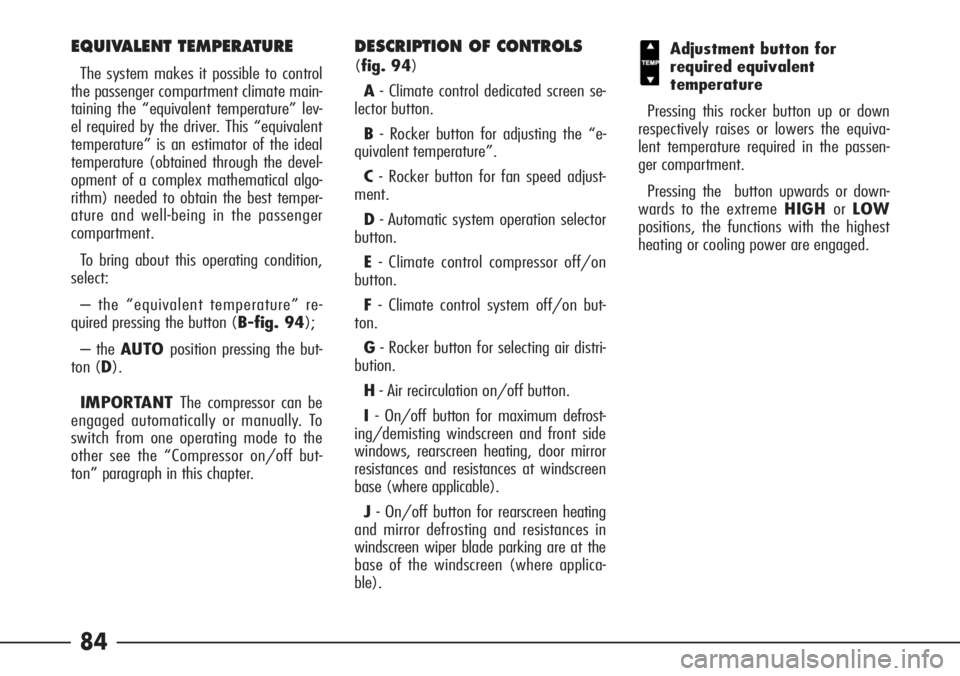
84
EQUIVALENT TEMPERATURE
The system makes it possible to control
the passenger compartment climate main-
taining the “equivalent temperature” lev-
el required by the driver. This “equivalent
temperature” is an estimator of the ideal
temperature (obtained through the devel-
opment of a complex mathematical algo-
rithm) needed to obtain the best temper-
ature and well-being in the passenger
compartment.
To bring about this operating condition,
select:
– the “equivalent temperature” re-
quired pressing the button (B-fig. 94);
– the AUTOposition pressing the but-
ton (D).
IMPORTANT The compressor can be
engaged automatically or manually. To
switch from one operating mode to the
other see the “Compressor on/off but-
ton” paragraph in this chapter.
DESCRIPTION OF CONTROLS
(fig. 94)
A- Climate control dedicated screen se-
lector button.
B- Rocker button for adjusting the “e-
quivalent temperature”.
C- Rocker button for fan speed adjust-
ment.
D- Automatic system operation selector
button.
E- Climate control compressor off/on
button.
F- Climate control system off/on but-
ton.
G- Rocker button for selecting air distri-
bution.
H- Air recirculation on/off button.
I- On/off button for maximum defrost-
ing/demisting windscreen and front side
windows, rearscreen heating, door mirror
resistances and resistances at windscreen
base (where applicable).
J- On/off button for rearscreen heating
and mirror defrosting and resistances in
windscreen wiper blade parking are at the
base of the windscreen (where applica-
ble).Adjustment button for
required equivalent
temperature
Pressing this rocker button up or down
respectively raises or lowers the equiva-
lent temperature required in the passen-
ger compartment.
Pressing the button upwards or down-
wards to the extreme HIGHorLOW
positions, the functions with the highest
heating or cooling power are engaged.
Page 87 of 272
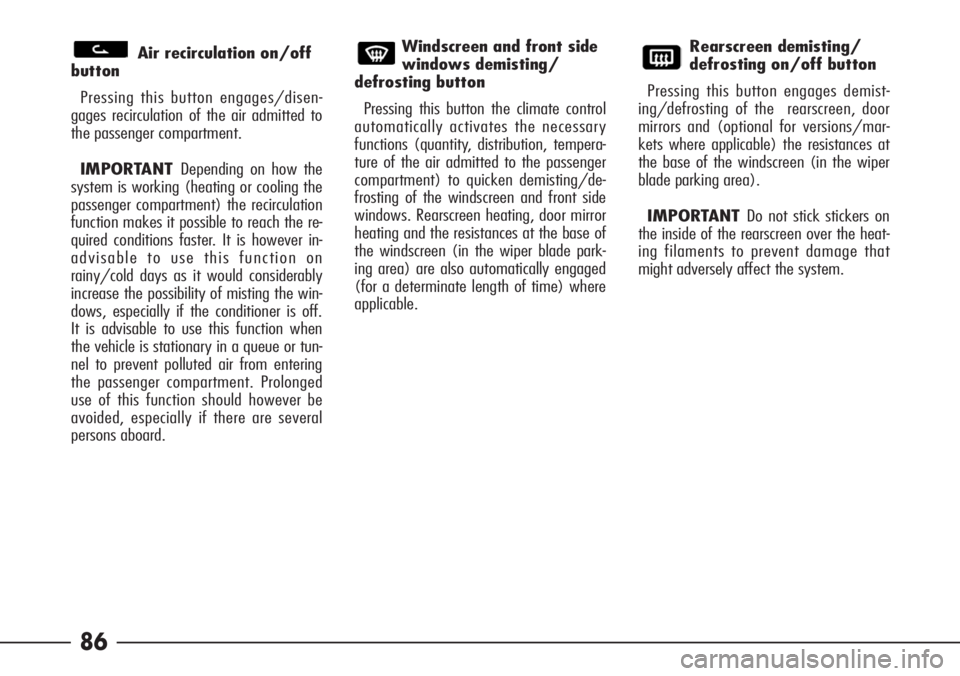
86
Air recirculation on/off
button
Pressing this button engages/disen-
gages recirculation of the air admitted to
the passenger compartment.
IMPORTANT Depending on how the
system is working (heating or cooling the
passenger compartment) the recirculation
function makes it possible to reach the re-
quired conditions faster. It is however in-
advisable to use this function on
rainy/cold days as it would considerably
increase the possibility of misting the win-
dows, especially if the conditioner is off.
It is advisable to use this function when
the vehicle is stationary in a queue or tun-
nel to prevent polluted air from entering
the passenger compartment. Prolonged
use of this function should however be
avoided, especially if there are several
persons aboard.Windscreen and front side
windows demisting/
defrosting button
Pressing this button the climate control
automatically activates the necessary
functions (quantity, distribution, tempera-
ture of the air admitted to the passenger
compartment) to quicken demisting/de-
frosting of the windscreen and front side
windows. Rearscreen heating, door mirror
heating and the resistances at the base of
the windscreen (in the wiper blade park-
ing area) are also automatically engaged
(for a determinate length of time) where
applicable.Rearscreen demisting/
defrosting on/off button
Pressing this button engages demist-
ing/defrosting of the rearscreen, door
mirrors and (optional for versions/mar-
kets where applicable) the resistances at
the base of the windscreen (in the wiper
blade parking area).
IMPORTANT Do not stick stickers on
the inside of the rearscreen over the heat-
ing filaments to prevent damage that
might adversely affect the system.
Page 90 of 272
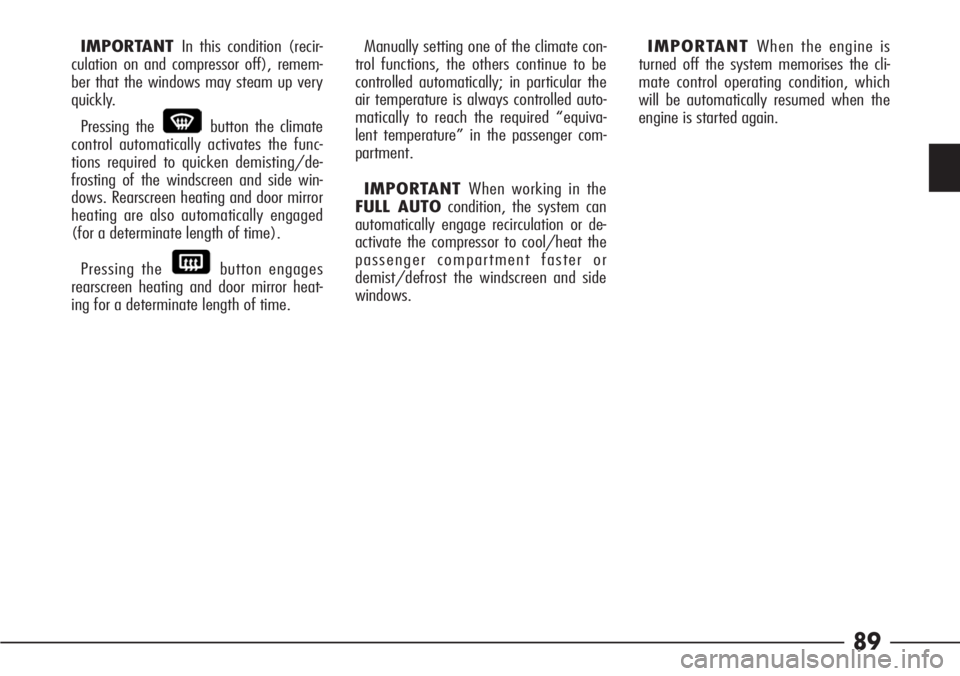
89
IMPORTANT In this condition (recir-
culation on and compressor off), remem-
ber that the windows may steam up very
quickly.
Pressing the button the climate
control automatically activates the func-
tions required to quicken demisting/de-
frosting of the windscreen and side win-
dows. Rearscreen heating and door mirror
heating are also automatically engaged
(for a determinate length of time).
Pressing the button engages
rearscreen heating and door mirror heat-
ing for a determinate length of time.Manually setting one of the climate con-
trol functions, the others continue to be
controlled automatically; in particular the
air temperature is always controlled auto-
matically to reach the required “equiva-
lent temperature” in the passenger com-
partment.
IMPORTANT When working in the
FULL AUTOcondition, the system can
automatically engage recirculation or de-
activate the compressor to cool/heat the
passenger compartment faster or
demist/defrost the windscreen and side
windows.IMPORTANT When the engine is
turned off the system memorises the cli-
mate control operating condition, which
will be automatically resumed when the
engine is started again.
Page 92 of 272
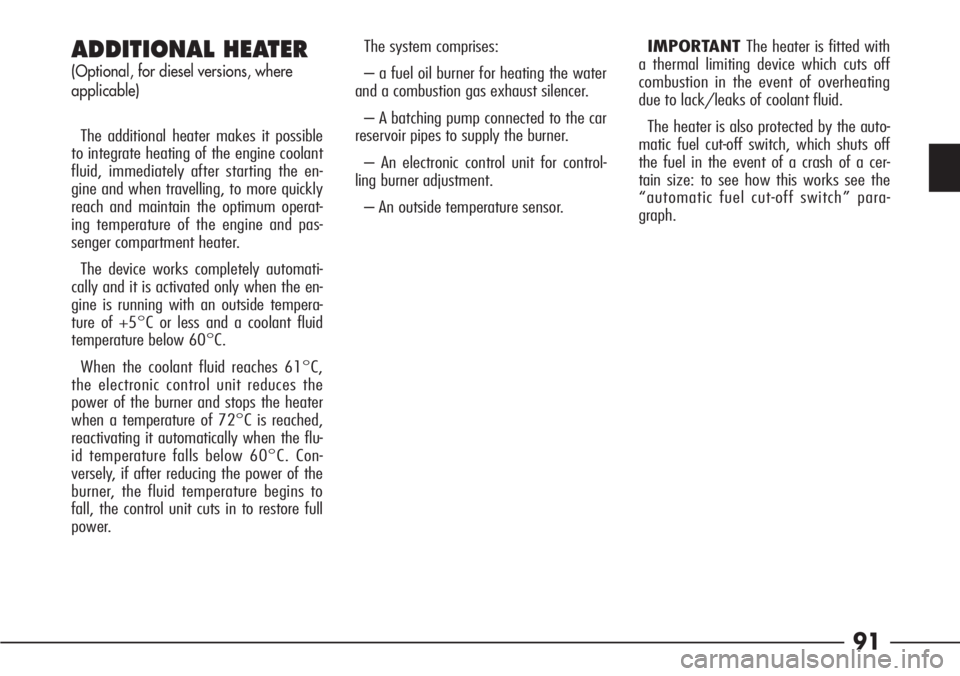
91
ADDITIONAL HEATER
(Optional, for diesel versions, where
applicable)
The additional heater makes it possible
to integrate heating of the engine coolant
fluid, immediately after starting the en-
gine and when travelling, to more quickly
reach and maintain the optimum operat-
ing temperature of the engine and pas-
senger compartment heater.
The device works completely automati-
cally and it is activated only when the en-
gine is running with an outside tempera-
ture of +5°C or less and a coolant fluid
temperature below 60°C.
When the coolant fluid reaches 61°C,
the electronic control unit reduces the
power of the burner and stops the heater
when a temperature of 72°C is reached,
reactivating it automatically when the flu-
id temperature falls below 60°C. Con-
versely, if after reducing the power of the
burner, the fluid temperature begins to
fall, the control unit cuts in to restore full
power.The system comprises:
– a fuel oil burner for heating the water
and a combustion gas exhaust silencer.
– A batching pump connected to the car
reservoir pipes to supply the burner.
– An electronic control unit for control-
ling burner adjustment.
– An outside temperature sensor.IMPORTANT The heater is fitted with
a thermal limiting device which cuts off
combustion in the event of overheating
due to lack/leaks of coolant fluid.
The heater is also protected by the auto-
matic fuel cut-off switch, which shuts off
the fuel in the event of a crash of a cer-
tain size: to see how this works see the
“automatic fuel cut-off switch” para-
graph.